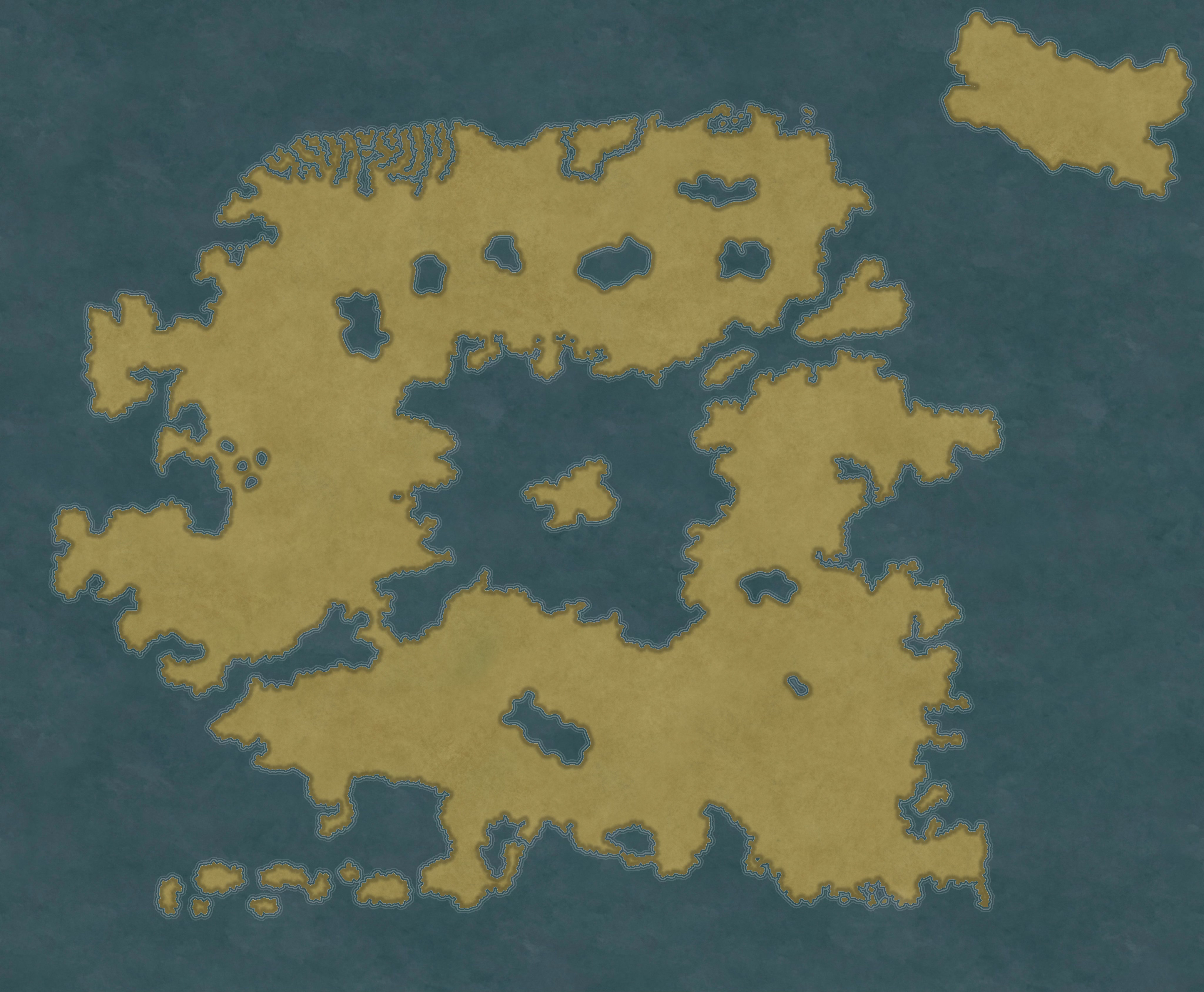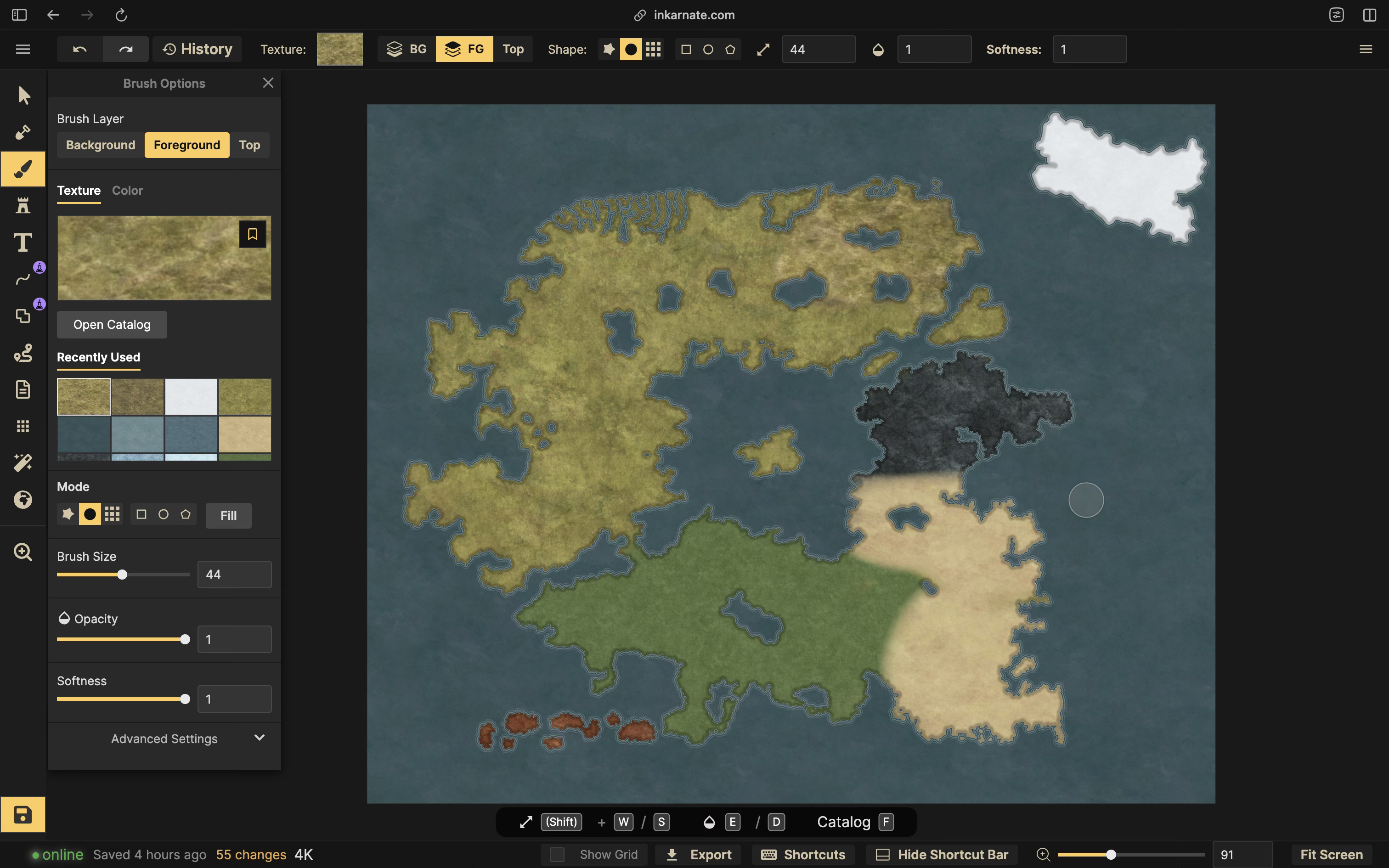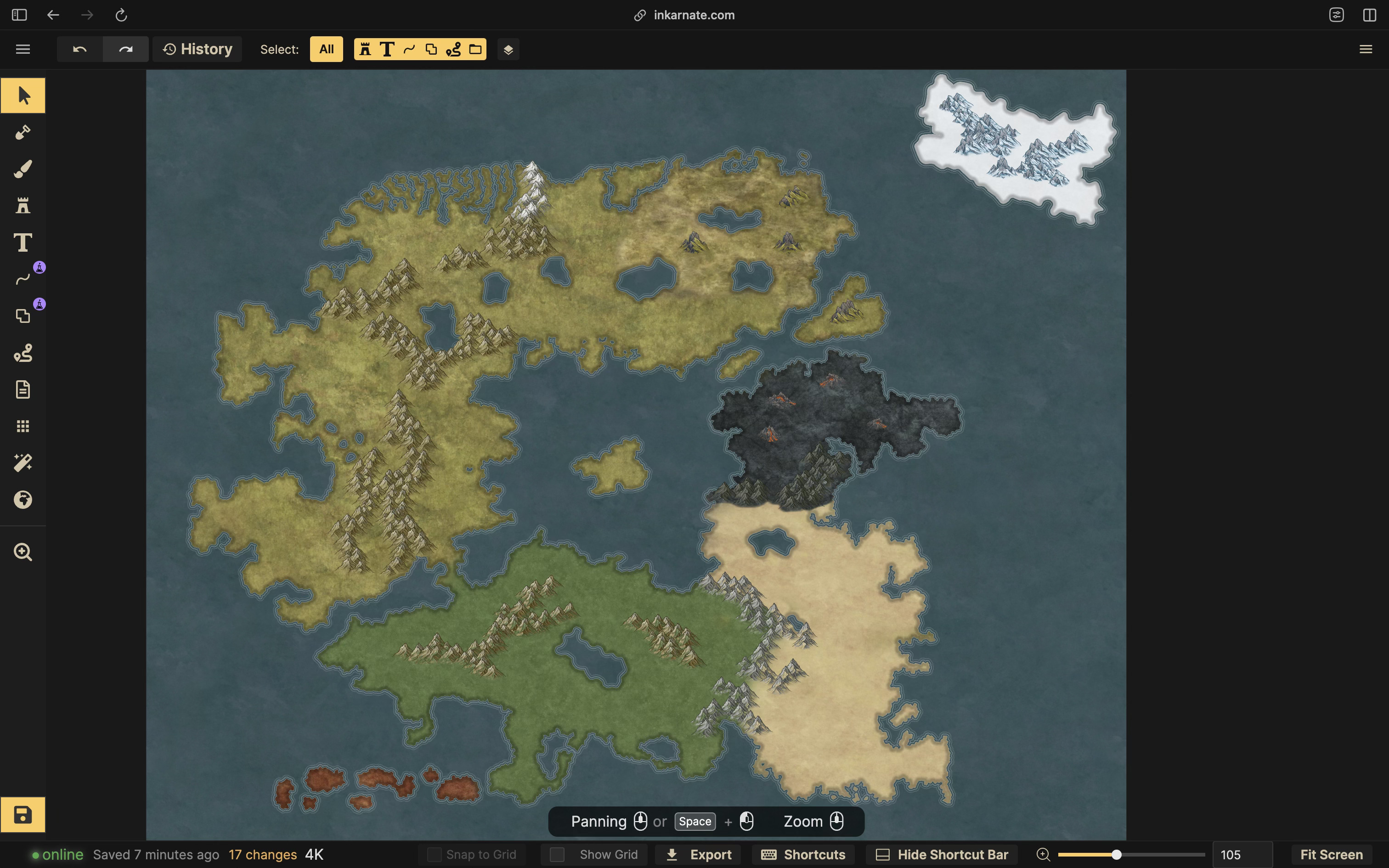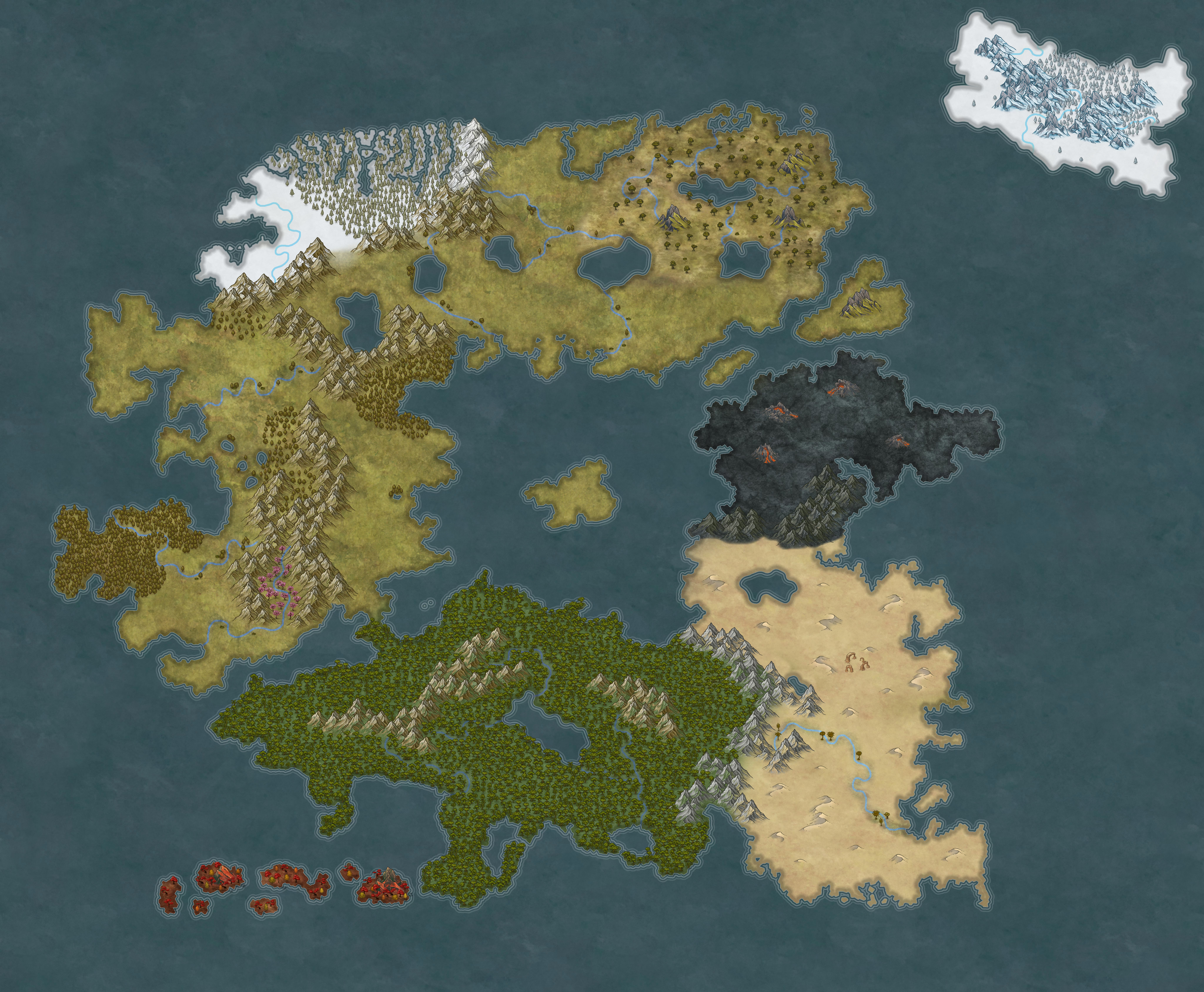Building Merithaya: The First Continent
Part 5 of a series of articles where I'm building a world called Merithaya from scratch, complete with in-world snippets and creation process
Hello again! Now that we’ve got some of our global elements in place, we can start zooming in and working on some more specific locations! In the next series of posts we will work on building out our first continent, from geography to countries and all the details within! In this first part, we’ll cover the following:
- Realism vs. Consistency
- Tools
- Basic Outline
- Natural Features
Realism vs. Consistency
Before we get into making our continent, it’s worth going on a quick sideline to talk about realism and consistency in worldbuilding, as this will have a big impact on how we make our continent.
When building a world for a story or TTRPG, we want to make our worlds believable, so that readers or players can immerse themselves in all the wonders and details that unfold there. To achieve this, we need to focus on two particular variables that have a big impact on overall believeability:
- How closely the world follows the rules of our real world in which we live. I think of this as Realism.
- How closely the world follows the rules we set out for it internally. I think of this as Consistency.
Worlds and stories don’t need to be realistic to be believable, as long as they are consistent. For example, you can have a story in which there is magic water that flows uphill - as long as all sources of this water behave the same way!
Why am I talking about this now? Well, you will see many tutorials online for map-making and worldbuilding that focus on realism - for example, suggesting that to make realistic mountains you need to plan fault lines, layout the mountains along them based on plate tectonics, etc. While this is a very valid way of making an interesting and detailed world, it isn’t the way I like to do my worldbuilding for D&D and TTRPGs for a few reasons:
- Worlds where magic and wonders beyond our world exist will be subject to different rules, and it is likely that will have a significant impact on the world. For example, catastrophic spells may raise mountains or carve new waterways, that would defy how these things may naturally develop
- It can be a source of wonder and whimsy to have things that don’t function exactly as they do in the real world - part of the joy for many people of exploring a fantasy world, whether in game or story, is to experience things that could never be seen in our normal real world
Due to this, you’ll see me focus on consistency rather than realism when designing Merithaya, although some natural features will naturally (pun intended) follow realism rules as we also don’t want to burden ourselves with lots of complexity where we don’t need to, and it’s generally easier to have things function as they do in reality when describing scenery to your players or readers. This will also make the non-realistic elements stand out and be special!
With that, onto designing our continent!
Tools
As part of this design process we are going to need to map out our continent. There are a bunch of great tools available for this if like me you struggle artistically - two I’ve used in particular are Inkarnate and Wonderdraft, although there are many other options - or you can stick to paper and pencil if you prefer! Most of the tips here will apply regardless of your tool and medium. I’ll be using Inkarnate here as they have a bunch of nice artwork stamps available to use and I want that kind of detailed drawing effect for my final map.
Basic Outline
Now that we’ve picked our map making tool, we can start to think about designing our continent. The very first thing to think about is the overall shape/outline of the landmass. Is it going to be one large area? A bunch of smaller islands in an archipelago? Are there bays or any interesting coastline features?
It can be daunting to be faced with a blank slate like this, so a good starting point can be to think of the story you want to tell in this place and what features would make that more compelling. Do you want an expedition across a frozen northern tundra? Then maybe you want some long fjords to navigate, and a larger landmass that will provide plenty of distance to cover in an epic trek. Or do you want a saga of two warring countries, in which case maybe two smaller areas connected by a key land bridge to control would lead to some interesting landscape to conflict over? In general, some things to consider that might affect your choices:
- Is there specific politics or history that might either have had an impact on the land, or the land will have an impact on?
- Is there a story point that will require a specific feature? For example a sea to meet pirates on, islands to find treasure on, or coves to meet merfolk?
For my continent, I like the idea of a large inland sea, that will be surrounded by land and only accessible through one or two narrow inlets - this gives the possiblity of naval encounters as the surrounding countries vie for control of trade on the sea and surrounding ocean, which is something I’d like to feature in some stories I set here!
I also picture this setting having been the site of a magical war in the past, which has had a profound impact on the landscape - I’m thinking there will be an island in the centre of the inland sea which will have been the crux of the war, perhaps this is even why the sea exists in the first place! This will also have an impact on the natural features that exist here, which we’ll get to later.
Lastly, this continent is likely to be the site of several stories in a longer campaign, so should be large enough to have a few countries and a variety of biomes. The scale here is important, as this determines the level of detail on the coastline. For example, for a map that only covers a small area, you would maybe have a simpler coastline as the features would be “zoomed in”, whereas for a larger scale map you want lots of coastal detail as there will be numerous bays, headlands, fjords, and small islands that dot the coast.
With all this considered, I outlined a rough draft of the continent that lined up with these specifications:

Natural Features
Biomes
This is a good starting point, but is looking a little bland, so we should start adding some natural features. I like doing this before planning out countries and settlements, as it can give inspiration for some interesting details of those cultures (for example, a settlement in an enchanted forest might have a strong fey vibe).
A good first step is to work out the rough biomes we want to include, and vaguely map them out - we can adjust later, but it gives a good prompt for where we might want mountains to divide them, or where forests and other features might be. I used Inkarnate’s brushes to paint on some rough shapes - it took a few goes to get something that felt like a good layout!

I originally started out making the whole north a frozen tundra, however that started feeling a bit cliched and my previous campaigns have both featured this, so I confined the snowy landscape to the island in the north. After deciding this, I quite liked the idea of some seasonal locations as a concept to tie in with our pantheon (a temple for each deity in a specific location that matches them, for example?) so I made the islands to the south autumnal themed.
Rainforests are always a great D&D location - the possibility for strange creatures, lost temples, and epic flora gives so many story possibilities - so I added a large section of this to the south (for any of my players they will know this is a bit of a common thread in my stories, but I’ll stick with it for now!). My last campaign featured a prominent desert, so I don’t want a large area of this in this world, but again the story and plot hook possibilities mean a smaller area is still a good idea, and it’ll give variety to the countries that we end up adding here.
Lastly, two slightly different sections - the northern section was looking a bit samey, so a section of swampland broke it up a bit and fits with the larger number of lakes - I picture this more boggy rather than tropical swamp, but we’ll see how it goes. Finally, volcanic areas make for a totally different environment for players to explore, with dangerous obstacles to overcome, so a small area of that on the west coast - I think this will tie into the magical war to explain its localisation, but we can refine that as we go.
Details
The map is starting to form, but is lacking detail. The dividing lines between the areas are a bit harsh, but we can fix that with the next staple of world design - mountain ranges! Here we want to divide off the areas to make for more natural transitions between environment types, as well as making divisions for country borders. Using Inkarnate’s stamps, we can get some good mountain ranges pretty quickly - by overlapping the stamps it creates a pretty realistic looking mountain range. I used slightly different styles for the northernmost mountains to make them snow-capped, and a darker variant for the volcanic area. I then added some volcanos to the blasted wastes.

Next up is to add in some rivers. While realism isn’t my main concern here, I’m sticking with the traditional “rivers flow downhill” approach - so they should make their way from mountainous areas towards lakes and the sea. On a map of this scale we won’t include all the streams that might be found on a more detailed depiction, instead focussing on the main rivers of this continent. For this we can use Inkarnate’s path tool - using a blue colour with the “Hue” blend mode on darker terrain, and the “Darken” blend mode on snow. Rivers can bend and meander (unless you are adding a canal system or artificial/unrealistic watercourses of some sort, in which straighter routes make sense!), and are a great way to break up larger landmasses as well as provide obstacles to future travellers across the continent. They can also act as routes between the coast and inland locations for boats, making them an interesting transport route option!

Finally, we can add some details like forests and trees. In my case for Merithaya, the large green area in the south is going to be a rainforest, so will be pretty tree-heavy! Using Inkarnate’s foliage stamps, with the “Multiple” setting adjusted to a pleasing density (this can vary from 40 - 80 for my forests, but choose something that looks good to you!).
One particular recommendation I have is to make sure to tidy if you are using a tool like this that repeats stamps over a large area - in Inkarnate particularly the stamp tool will place stamps over water or any other terrain background, so make sure to go and remove overflowed trees that have snuck beyond your landmass’s boundaries to make sure you get a nice crisp effect along rivers and coasts. For example - in the below screenshot I painted the entire rainforest in trees, then went back and removed them along the river lines and coastlines to make them stand out!

Don’t forget areas like deserts when adding these details - we can still add a few plants along the water sources, as well as some rock features for explorers to visit in our stories!

Applying the same treatment to the rest of the continent, we’re starting to get a pretty good looking map!

A few points to note. Firstly, you’ll notice a new snowy area in the north-east! As I was adding details, I felt the north of the map felt a bit same-y - adding this new cold area breaks up the north a bit and provides a new type of biome to explore (arctic fjords).
I added a small area of blossom trees in the east that are the makings of a magical spring-themed forest - along with the autumnal isles to the south, the winter areas in the north, and the sunny desert areas of the west, we now have interesting season-themed areas that can link to our pantheon!
Lastly, we’ll be coming back to this and tweaking it as we add settlements, roads, and other points of interest in the next post - so it’s expected at this stage that some of this won’t be the final layout of our continent. Still, I’m really happy with how this is turning out!
Wrap Up
Wow - this has been a marathon post, hopefully you can see why it took a little longer than normal to produce (Also apologies for a lack of in-world writing this time - we’ll get there next time!)! I’m going to stop here for now, and continue with this in part 2, where we will look at countries, settlements, other landmarks, and give this continent a name!
Don’t forget to subscribe if you’d like to get that post, and all future updates, as they are published!
And feel free to share this or my publication in general if there is someone you know who likes worldbuilding and would hopefully find it useful!
Thanks so much for reading, and see you next time!
